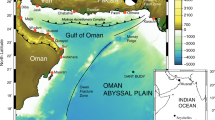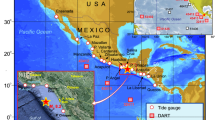Abstract
The main objectives of this study are evaluating the statistical and spectral properties of tsunami waves as well as their energy behavior associated with the worst-case Makran seismic scenarios. The role of the Oman continental shelf in the tsunami wave propagation also investigated. In this study, the hybrid numerical model, GEOWAVE, is implemented for the entire life of the tsunami, including wave generation, propagation, and inundation. To study the statistical and frequency characteristics of the two worst-case tsunami waves (Mw 9.1 and 8.3), 36 artificial gage stations considered. The ports of Konarak, Sepah, Shahid Beheshti, Shahid Kalantari, and the Iran Bandar port were selected to analyze the frequency behavior of waves inside the ports. Based on spectral analysis of different stations in the Chabahar Bay, a two-period range of 15–25 min and 50–58 min for the Mw 9.1 are dominant. For the Mw 8.3, the maximum two dominant period ranges are 8–16 and 20–32 min. The wavelet analysis for Mw 9.1 indicates that for stations 1 to 30, the tsunami energy spread for the first 2 h after the tsunami arrived at these stations in a relatively wide range of 15–58 min, and then limited within the slightly narrower range. For Mw 8.3, the period range of 25–54 min for the first 4 h is dominant and then focuses on a smaller scope. Frequency-time graphs show that the energy of a tsunami can move between different period intervals at different times.


















Similar content being viewed by others
References
Akbarpour Jannat MR, Noranian Esfahani M, Chegini V, Rezanejad K (2011) Hazards associated with tsunami waves in the Gulf of Oman. J Coast Res SI64:865–869. https://doi.org/10.2307/26482296
Akbarpour Jannat MR, Rastgoftar E (2015) Numerical modeling of tsunami waves associated with worst earthquake scenarios of the Makran subduction zone in the Jask Port, Iran. J Persian Gulf 6(22):35–47
Akbarpour Jannat MR, Rastgoftar E, Asano T (2017) Tsunami assessment for inundation risk management at Chabahar Bay facilities in Iran. IJCOE 1(2):27–39. https://doi.org/10.18869/acadpub.ijcoe.1.2.27
Ando M (1975) Source mechanisms and tectonic significance of historical earthquakes along the Nankai trough, Japan. Tectonophysics 27(2):119–140
Bellotti G, Briganti R, Beltrami GM (2012) The combined role of bay and shelf modes in tsunami amplification along the coast. Journal of Geophysical Research, Oceans 117(C8)
Bourget J, Zaragosi S, Ellouz-zimmermann N, Mouchot N, Garlan T, Schneider J, Lanfumay V, Lallemant S (2011) Turbidite system architecture and sedimentary processes along topographically complex slopes: the Makran convergent margin. Sedimentology 58:376–406
Byrne DE, Sykes LR, Davis DM (1992) Great thrust earthquakes and aseismic slip along the plate boundary of the Makran subduction zone. J Geophys Res 97:449–478
Dragani WC, D’onofrio EE, Grismeyer W, Fiore ME (2006) Tide gauge observations of the Indian ocean tsunami, December 26, 2004, in Buenos Aires coastal waters, Argentina. Cont Shelf Res 26:1543–1550
Fujii Y, Satake K, Sakai S, Shinohara M, Kanazawa T (2007) Tsunami source of the 2004 Sumatra Andaman earthquake and the Indian Ocean Tsunami. Bull Seismol Soc Am 97(1A):S192–S207
Fujii Y, Satake K, Sakai S, Shinohara M, Kanazawa T (2011) Tsunami source of the 2011 off the Pacific coast of Tohoku Earthquake. Earth Planets Space 63:815–820
Geist E, Titov V, Synolakis C (2006) Tsunami: wave of change. Sci Am (January) 294:56–63
Goupillaud P, Grossman A, Morlet J (1984) Cycle-Octave and related transforms in seismic signal analysis. Geoexploration 23:85–102
Grilli ST, Ioualalen M, Asavanant J, Shi F, Kirby J, Watts P (2007) Source constraints and model simulation of the December 26, 2004 Indian Ocean Tsunami. J Wtrwy, Port, Coast, and Oc Engrg 133(6):414–428
Grilli ST, Harris JC, Tajali-Bakhsh TS, Tappin DR, Masterlark T, Kirby JT, Shi F, Ma G (2012) Recent progress in the nonlinear and dispersive modeling of tsunami generation and coastal impact: application to Tohoku 2011. Conference of Hydrodynamics, France 21–23
Heck NH (1947) List of seismic sea waves. Bull Seismol Soc Am 37(4):269–286
Heidarzadeh M, Pirooz MD, Zaker NH, Yalciner AC, Mokhtari M, Esmaeily A (2008) Historical tsunami in the Makran subduction zone off the southern coasts of Iran and Pakistan and results of numerical modeling. Ocean Eng 35(8-9):774–786
Heidarzadeh M, Pirooz MD, Zaker NH, Yalciner AC (2009a) Preliminary estimation of the tsunami hazards associated with the Makran subduction zone at the northwestern Indian Ocean. Nat Hazards 48(2):229–243
Heidarzadeh M, Pirooz MD, Zaker NH (2009b) Modeling the near-field effects of the worst-case tsunami in the Makran subduction zone. Ocean Eng 36(5):368–376
Heidarzadeh M, Kijko A (2011) A probabilistic tsunami hazard assessment for the Makran subduction zone at the northwestern Indian Ocean. Nat Hazards 56(3):577–593
Heidarzadeh M, Satake K (2013a) The 21 May 2003 tsunami in the Western Mediterranean Sea: statistical and wavelet analyses. Pure Appl Geophys 170(9–10):1449–1462
Heidarzadeh M, Satake K (2013b) Waveform and spectral analyses of the 2011 Japan tsunami records on tide gauge and DART stations across the Pacific Ocean. Pure Appl Geophys 170(6–8):1275–1293
Heidarzadeh M, Satake K (2014) Possible sources of the tsunami observed in the Northwestern Indian Ocean following the 2013 September 24 Mw = 7.7 Pakistan inland earthquake. Geophys J Int 199:752–766
Heidarzadeh M, Satake K (2015) New insights into the source of the Makran tsunami of 27 November 1945 from tsunami waveforms and coastal deformation data. Pure Appl Geophys 172:621–640
Heidarzadeh M, Satake K (2017) A combined earthquake–landslide source model for the tsunami from the 27 November 1945 Mw 8.1 Makran Earthquake. Bulletin of the Seismological Society of America 107(2)
Hoechner A, Babeyko AY, Zamora N (2015) Probabilistic tsunami hazard assessment for the Makran region with focus on maximum magnitude assumption. Nat Hazards Earth Syst Sci Discuss 3:5191–5208
Hoechner A, Babeyko AY, Zamora N (2016) Probabilistic tsunami hazard assessment for the Makran region with focus on maximum magnitude assumption. Nat Hazards Earth Syst Sci 16:1339–1350
Hoffmann G, Rupprechter N, Albalushi N, Grutzner C, Reichter K (2013) The impact of the 1945 Makran tsunami along the coastlines of the Arabian Sea (Northern Indian Ocean) – a review. Z Geomorphol 57(4):257–277
Ioualalen M, Pelletier B, Regnier M, Watts P (2006) Numerical modeling of the 26th November 1999 Vanuatu tsunami. J Geophys Res 111:C06030. https://doi.org/10.1029/2005JC003249
Jaiswal RK, Rastogi BK, Murty TS (2008) Tsunamigenic sources in the Indian Ocean. Sci Tsunami Haz 27(2):32–53
Jaiswal RK, Singh AP, Rastogi BK (2009) Simulation of the Arabian Sea tsunami propagation generated due to 1945 Makran earthquake and its effect on western parts of Gujarat (India). Nat Hazards 48(2):245–258
Joseph A, Odametey JT, Nkebi EK, Pereira A, Prabhudesai RG, Mehra P, Rabinovich AB, Kumar V, Prabhu-Desai S, Woodworth P (2006) The 26 December 2004 Sumatra tsunami recorded on the coast of West Africa. Afr J Mar Sci 28(3-4):705–712
Kennedy AB, Chen Q, Kirby JT, Dalrymple RA (2000) Boussinesq modeling of wave transformation, breaking, and runup; I: 1D. J Wtrwy, Port, Coast, and Oc Engrg 126(1):39–47
Koppa C, Fruehn J, Flueh ER, Reichert C, Kukowski N, Bialas J, Klaeschen D (2000) Structure of the Makran subduction zone from wide-angle and reflection seismic data. Tectonophysics 329:171–191
Mathworks (2018) MATLAB user manual. MathWorks Inc., MA 282 p
Neetu S, Suresh I, Shankar R, Nagarajan B, Sharma R, Shenoi SSC, Unnikrishnan AS, Sundar D (2011) Trapped waves of the 27 November 1945 Makran tsunami: observations and numerical modeling. Nat Hazards 59(3):1609–1618
Okada Y (1985) Surface deformation due to shear and tensile faults in a half-space. Bull Seismol Soc Am 75(4):1135–1154
Okal A (2007) Seismic records of the 2004 Sumatra and other tsunamis: a quantitative study. Pure Appl Geophys 164:325–353
Okal EA, Synolakis CE (2008) Far-field tsunami hazard from mega-thrust earthquakes in the Indian Ocean. Geophys J Int 172:995–1015
Okal EA, Fritz HM, Hamzeh MA, Ghasemzadeh J (2015) Field survey of the 1945 Makran and 2004 Indian Ocean tsunamis in Baluchistan, Iran. Pure Appl Geophys 172:3343–3356. https://doi.org/10.1007/s00024-015-1157-z
Oppenheim AV, Schafer RW (1975) Digital signal processing. Prentice-Hall publications, Englewood Cliffs ISBN 0-13-214635-5, 585 p
Page WD, Alt JN, Cluff LS, Plafker G (1979) Evidence for the recurrence of large-magnitude earthquakes along the Makran coast of Iran and Pakistan. Tectonophysics 52(1):533–547
Payande AR, Niksokhan MH, Naserian H (2015) Tsunami hazard assessment of Chabahar Bay related to megathrust seismogenic potential of the Makran subduction zone. Nat Hazards 76(1):161–176
Levin BW, Nosov MA (2016) Physics of Tsunamis
Plafker G (1972) Alaskan earthquake of 1964 and Chilean earthquake of 1960: implications for arc tectonics. Plate Tectonics Chapter 29:901–925. https://doi.org/10.1002/9781118782149.ch29
Quittmeyer RC, Jacob KH (1979) Historical and modern seismicity of Pakistan, Afghanistan, Northwestern India, and Southeastern Iran. Bull Seismol Soc Am 69:773–823
Rabinovich AB, Thomson RE (2007) The 26 December 2004 Sumatra tsunami: analysis of tide gauge data from the World Ocean Part 1. Indian Ocean and South Africa. Pure Appl Geophys 164:261–308
Rajendran CP, Ramanamurthy MV, Reddy NT, Rajendran K (2008) Hazard implications of the late arrival of the 1945 Makran tsunami. Curr Sci 95:1739–1743
Rajendran CP, Rajendran K, Shah-Hosseini M, Naderi Beni A, Nautiyal CM, Andrews R (2013) The hazard potential of the Western segment of the Makran subduction zone, Northern Arabian Sea. Nat Hazards 65:219–239
Rashidi A, Shomali ZH, Dutykh D, Keshavarz Farajkhah N (2018) Evaluation of tsunami wave energy generated by earthquakes in the Makran subduction zone. Ocean Eng 165:131–139
Rashidi A, Dutykh D, Shomali ZH, Keshavarz Farajkhah N, Nouri M (2020) A review of tsunami hazards in the Makran subduction zone. Geosciences 10(9):372. https://doi.org/10.3390/geosciences10090372
Rastgoftar E, Soltanpour M (2016) Study and numerical modeling of 1945 Makran tsunami due to a probable submarine landslide. Nat Hazards 83(2):929–945
Satake K, Tanioka Y (1999) Source of tsunami and tsunamigenic earthquakes in subduction zones. Pure Appl Geophys 154:467–483
Schellart WP, Rawlinson N (2013) Global correlations between maximum magnitudes of subduction zone interface thrust earthquakes and physical parameters of subduction zones. Phys Earth Planet Inter 225:41–67
Shah-Hosseini M, Morhange C, Naderi Beni AN, Marriner N, Lahijani H, Hamzeh MA, Sabatier F (2011) Coastal boulders as evidence for high-energy waves on the Iranian coast of Makran. Mar Geol 290(1-4):17–28
Siddiqui RH, Naka T, Munir UH, Brohi IA (2009) Early to Middle Jurassic radiolarian fauna from the Ras Koh arc and it tectonostratigraphic significance. Sindh Univ Res J 41:107–118
Smith GL, McNeill LC, Wang K, He J, Henstock TJ (2013) Thermal structure and megathrust seismogenic potential of the Makran subduction zone. Geophys Res Lett 40:1528–1533
Titov VV, Rabinovich AB, Mofjeld HO, Thomson RE, Gonzalez FI (2005) The global reach of the 26 December 2004Sumatra tsunami. Science 309:2045–2048
Titov VV, Moore CW, Greenslade DJM, Pattiaratchi C, Badal R, Synolakis CE, Kangolu U (2011) A new tool for inundation modeling: Community Modeling Interface for Tsunamis (ComMIT), Pure Appl. Geophys. 168:2121–2131
Torrence C, Compo G (1998) A practical guide to wavelet analysis. Bull Am Meteorol Soc 79:61–78
Watts P, Borrero JC, Tappin DR, Bardet JP, Grilli ST, Synolakis CE (1999) Novel simulation technique employed on the 1998 Papua New Guinea tsunami. Proceedings of 22nd General Assembly IUGG Birmingham UK JSS42 Abstract
Welch PD (1967) The use of fast Fourier transform for the estimation of power spectra: a method based on time averaging over short, modified periodograms. IEEE Trans. Audio Electroacoustics AU-15:70–73
Wells DL, Coppersmith KJ (1994) New empirical relationship among magnitude, rupture length, rupture width, rupture area and surface displacement. Bull Seismol Soc Am 84(4):974–1002
Acknowledgments
I am grateful to Prof. Toshiyuki Asano for the sabbatical opportunity which provided to the corresponding author in the Kagoshima University, Japan. I appreciate Dr. Ehsan Rastgoftar for the preliminary preparation of the modeling results from our previous joint research work which is considered for spectral analysis in this paper.
Funding
This study was supported by the Iranian National Institute for Oceanography and Atmospheric Science (INIOAS), IRAN.
Author information
Authors and Affiliations
Corresponding author
Additional information
Responsible Editor: Longjun Dong
Rights and permissions
About this article
Cite this article
Akbarpour Jannat, M.R. Tsunami modeling in the Chabahar Bay-Iran from worst-case Makran seismic scenarios: new insights into spectral characterization, separation of the continental shelf, and topography effects. Arab J Geosci 14, 208 (2021). https://doi.org/10.1007/s12517-021-06449-0
Received:
Accepted:
Published:
DOI: https://doi.org/10.1007/s12517-021-06449-0




